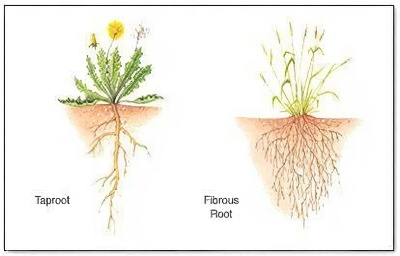Underground, plant’s unsung heroes, the roots, perform a plethora of functions that support land life. The roots keep the plant anchored in the soil to prevent them from being knocked over by strong winds or swept away by floods. They are the central place where water and soluble minerals in the soil are taken up and then transported upwards to the rest of the plant. Apart from their fundamental roles, roots are remarkably diverse, branching into many specialized types to allow plants to exist in a wide variety of environments. This discovery will explain the dominant forms of root systems and the fascinating adaptations they have evolved for plant survival.
The dominant taproot system
The taproot system is characterized by a single, large main primary root developing vertically down into the ground. This master root, which develops from the embryonic root, or radicle, becomes thick and fleshy in some plants and serves as a carbohydrate and water food storage organ. From this root, smaller lateral roots develop outwards in the horizontal plane, but these remain under the influence of the large taproot. This deep penetration into the ground is particularly useful for plants that occur in dry climates because it allows them to access deep water reservoirs underground.
Many common garden vegetables possess established taproot systems. Dandelions, carrots, beets, and radishes are some of them. Dandelions are a fine example of the hardness of a taproot because its taproot, being deeply anchored, makes it notoriously difficult to uproot entirely from the ground. A broken taproot will even produce a new shoot sometimes, demonstrating the system’s extreme survivability. Food storage also helps the plant survive overwintering and drought.
The extensive fibrous root system
Completely other than the single taproot is the fibrous root system, which is a vast spread of extremely dense many small, branching roots. Found primarily in monocots like grasses, wheat, rice, and corn, these roots extend horizontally and are nearer to the surface of the soil. The initial primary root that emerges out of the seed is typically temporary in such plants and consists of the entire system of adventitious roots that arise from the stem base. The root density of fibrous roots creates a mat that is highly effective at resisting soil erosion.
Even though a fibrous root system is less penetrating than a taproot, the shallow, broad network is very good at absorbing surface water and nutrients. This is particularly advantageous for plants in areas where there is too much moisture, such as dense grasslands. For example, the fibrous root system of lawn grasses is one of the chief reasons why they create such a firm grip on soil and are therefore commonly utilized in erosion control. Their thick root mat also provides excellent anchorage to the plant even without any individual deep central root.
Adventitous roots: A source of versatility
Adventitious roots are a category of roots that develop from another portion of the plant, other than the radicle or another root, i.e., the stem, leaves, or old woody roots. They are the main component of the fibrous root system but occur in many other specialized forms as well. This ability to form roots from unusual positions is a robust adaptation that enables one to cope with stress, propagate asexually, and colonize new environments. The majority of propagation technique, for example, growing new plants from cuttings, relies entirely on adventitious root development.
There are myriad examples of adventitious roots and they are stupendous adaptations. Mangroves, living on waterlogged coastal areas, develop specialized adventitious roots referred to as pneumatophores that rise towards the surface to enable the exchange of gases. Conversely, ivy and certain orchids use adventitious roots for climbing and holding onto surfaces. In this way, diversification makes adventitious roots a foundation of survival for many plant species in diverse and hostile habitats.
Supportive and climbing roots
Some of the most visually striking examples of root modification are those that provide enhanced mechanical support to the plant’s structure. This is necessary for heavy, tall, or weak-stemmed plants that otherwise could be prone to wind destruction. These roots will often originate from stems or branches high above the ground level and fall downwards, eventually grasping the soil to act as additional support. The banyan tree gives a spectacular display, with branches hanging down to form prop roots in the shape of curtains, which, with time, turn into thick pillar-like trunks that can sustain a wide canopy.
Another type, stilt roots, arise from the lower part of the stem and grow obliquely into the soil. They are particularly common in plants that are growing in loose or insecure soil, providing a wide supporting base in the shape of stilts. Maize and sugarcane are just a couple of the famous plants that utilize stilt roots to remain upright. The adaptation is useful where the primary root system cannot support the plant from falling over. Buttress roots in large trees in tropical rainforests are another example, forming great plank-like structures at the bottom to provide stability where there is thin, poor soil.
Respiratory and moisture-absorbing roots
Certain environments present a particular challenge to root respiration, a critical oxygen-requiring process. Plants in marsh or waterlogged environments where oxygen levels are low have evolved specialized respiratory roots known as pneumatophores. The roots force themselves vertically upward, protruding above the waterlogged mud or soil in the form of small spikes to absorb oxygen from the air. The mangrove tree is the best illustration of a pneumatophore plant as it thrives in oxygen-deficient saline mudflats.
Other roots have adapted to extract water from the air directly, an adaptation that is crucial to epiphytes. Epiphytes such as orchids grow upon host plants rather than soil, and therefore must acquire water in alternate ways. Their air roots are padded with a spongy, porous tissue called the velamen that has the ability to absorb atmospheric water in the form of rain, dew, or humidity. Such roots are an incredible example of how plants can survive even when their usual access to soil resources is completely denied.
Parasitic, photosynthetic, and reproductive roots
The realm of root modifications extends even further into bizarre and very specialized functions. Parasitic plants, as dodder and mistletoe, form haustorial roots which pierce the tissue of their host plant for obtaining water and nutrients. They are thereby able to steal resources directly, typically at the host’s expense. Some plants have evolved assimilatory or photosynthetic roots. These roots can contain chlorophyll and are green and are able to perform photosynthesis, especially in plants with reduced or no leaves.
Roots also can be altered for reproduction, known as vegetative propagation. Propagative roots will develop adventitious buds that create new plantlets, allowing the plant to reproduce without seeds. Vegetables like the sweet potato possess tuberous roots that not only get altered for food storage but also serve to grow new plants. Contractile roots are a fascinating adaptation, which are found in bulbous plants like lilies. Contractile or short roots pull the bulb deeper into the soil to protect it against temperature fluctuations.
Ecological importance of roots
Investigation of the different types of roots and their adaptations is important for an understanding of plant biology and its ecological significance. The long, extensive taproots of some plants, for example, account for cycling nutrients and accessing water tables far beyond the capabilities of other vegetation. The turf-like consistency of fibrous root systems plays a significant role in soil stabilization and preventing erosion. All these differently built root systems influence everything from forest ecosystems to the stability of a small grassland.
The diversity in the human world is just as mind-boggling, with many crops depending on specific root modifications. Carrots and potatoes that we eat are storage roots, having evolved to provide us with energy. Farmers and horticulturists also use the principles of adventitious root initiation in vegetative propagation to produce plants of desirable traits, cloning them. From the intricate web of a rainforest floor to our reassuring vegetables on the table, the hidden world of roots shows the incredible flexibility and sophistication of plants.

